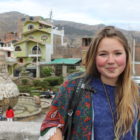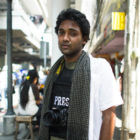
Brian Pellot (left) and Jabu Pereira. Photo: Daylin Paul
Russian version is here. Русская версия здесь.
In some countries reporting on LGBTQ issues can be dangerous for reporters as well as their sources. Which is why it is important to understand how to implement safe and responsible practices for LGBTQ reporting.
At #GIJC17 in Johannesburg this week, several experts gathered to discuss how how to best investigate LGBTQ issues.
Brian Pellot, director of Global Strategy, Religion News Foundation; Jabu Pereira,director and founder of Iranti, a media advocacy organization for African Trans, Lesbian, and Intersex communities; and Selly Thiam, founder of None On Record, an African media outlet documenting LGBTQ stories, combined their expertise with data professor and Knight Chair in Investigative Reporting at the University of Illinois, Brant Houston.
Following are eight tips and a round-up of resources from the talk.
1. Minimize Hate Speech
When your editor says: you need to “get the other side of the story,” reporters need to question the role of the other side, says Pellot. What will it achieve? “We must push back against false balance.” We must be careful when finding the opposite voice. We need to question what hate speech is and understand how to identify when hate speech is dangerous, and we must always strive to include moderate voices.
2. Be Objective
This is a difficult issue when the lines of advocacy are often blurred in subjectivity. Your editor might call you an advocate if you are an LGBTQ person reporting on LGBTQ issues. Simultaneously, as journalists, we must always know our own personal limits. If we feel we can’t be objective, we should pass the story on to a colleague.
3. Give People Autonomy to Tell Their Own Stories
It is not up to a cisgender person to ask “when did you know you were born in the ‘wrong’ body?” No one is born into the wrong body and it is up to the LGBTQ person to describe and define their own experiences,” Pereira explains.
4. Understand the Terminology and Use it Respectfully
It is important to allow your interviewee or subject to choose their own gender pronoun. Journalists need to frame their stories sensitively around the identity of their subjects and make sure that this terminology is described in their coverage. In his report entitled “Covering Sexual and Gender Minorities and Religion in Sub Saharan Africa,” Pellot provides an extensive list of LGBTQ terms.
5. Stop Shallow Reporting
We need to look into the structural roots of inequality. “We need to describe the Intersectional issues,” says Pereira. Unemployment, homelessness, stigmatization and family killings are all results of oppression and it is important to reflect these details in our coverage.
6. Go Deeper: How Do We Establish Hate Crime?
In the courts, hate crimes can go unpunished and unacknowledged. These cases can disregard sexual identity as part of the crime and our job is to go deeper. Investigate the hate crime, find the facts and expose the root of the issue.
7. Protect Yourself When Reporting on LGBT Issues
If you are in a country where you cannot cover LGBT issues safely, it is important to know how to protect yourself. Security in a Box is a great resource.
8. Use Current Reports to Find Data Sources
Houston advises reporters to “always read the index, annotations or footnotes on any report. That’s where you can get hints on where any data can be.”
Plus: Recommended Databases and Resources
-
- GIJN report for LGBTQ Resources by Toby McIntosh.
- A comprehensive guide for journalists covering LGBTQ issues in Sub-Saharan Africa by Brian Pellot: Covering Sexual and Gender Minorities & Religion in Sub Saharan Africa.
- International Network for Hate Studies
- Rainbow Map: This database keeps track of all the protection laws in each European country.
- Documenting Hate: ProPublica’s database for hate crimes.
- Trans Murder Monitoring (TMM) project: A database that monitors and collects homicides of trans people worldwide.
- Reveal, The Center for Investigative Reporting’s, report on murder rates of trans people in the US.
 Zita Campbell graduated from Otago University, New Zealand, in 2015 with a double major in theatre, film and media, completing the last year of her bachelor’s degree at the University of California Santa Cruz. She has worked as a freelancer in London and plans to specialize in longform and documentaries on humanitarian and environmental issues.
Zita Campbell graduated from Otago University, New Zealand, in 2015 with a double major in theatre, film and media, completing the last year of her bachelor’s degree at the University of California Santa Cruz. She has worked as a freelancer in London and plans to specialize in longform and documentaries on humanitarian and environmental issues.
 Daylin Paul is an independent photographer, visual journalist and photojournalism educator based in Johannesburg. He is the 2017 winner of the Ernest Cole Award for Photography for his documentary Broken Land and the 2017 Hostwriter Pitch Prize for Collaborative Journalism. His work has appeared in The New York Times, The Guardian, Foreign Policy, and Financial Times.
Daylin Paul is an independent photographer, visual journalist and photojournalism educator based in Johannesburg. He is the 2017 winner of the Ernest Cole Award for Photography for his documentary Broken Land and the 2017 Hostwriter Pitch Prize for Collaborative Journalism. His work has appeared in The New York Times, The Guardian, Foreign Policy, and Financial Times.
